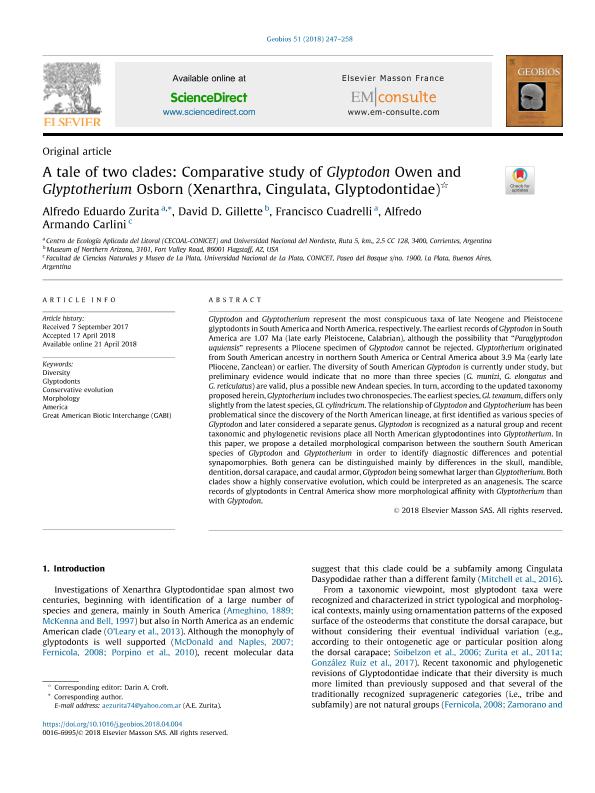Artículo
A tale of two clades: Comparative study of Glyptodon Owen and Glyptotherium Osborn (Xenarthra, Cingulata, Glyptodontidae)
Fecha de publicación:
06/2018
Editorial:
Elsevier France-editions Scientifiques Medicales Elsevier
Revista:
Geobios
ISSN:
0016-6995
Idioma:
Inglés
Tipo de recurso:
Artículo publicado
Clasificación temática:
Resumen
Glyptodon and Glyptotherium represent the most conspicuous taxa of late Neogene and Pleistocene glyptodonts in South America and North America, respectively. The earliest records of Glyptodon in South America are 1.07 Ma (late early Pleistocene, Calabrian), although the possibility that “Paraglyptodon uquiensis” represents a Pliocene specimen of Glyptodon cannot be rejected. Glyptotherium originated from South American ancestry in northern South America or Central America about 3.9 Ma (early late Pliocene, Zanclean) or earlier. The diversity of South American Glyptodon is currently under study, but preliminary evidence would indicate that no more than three species (G. munizi, G. elongatus and G. reticulatus) are valid, plus a possible new Andean species. In turn, according to the updated taxonomy proposed herein, Glyptotherium includes two chronospecies. The earliest species, Gl. texanum, differs only slightly from the latest species, Gl. cylindricum. The relationship of Glyptodon and Glyptotherium has been problematical since the discovery of the North American lineage, at first identified as various species of Glyptodon and later considered a separate genus. Glyptodon is recognized as a natural group and recent taxonomic and phylogenetic revisions place all North American glyptodontines into Glyptotherium. In this paper, we propose a detailed morphological comparison between the southern South American species of Glyptodon and Glyptotherium in order to identify diagnostic differences and potential synapomorphies. Both genera can be distinguished mainly by differences in the skull, mandible, dentition, dorsal carapace, and caudal armor, Glyptodon being somewhat larger than Glyptotherium. Both clades show a highly conservative evolution, which could be interpreted as an anagenesis. The scarce records of glyptodonts in Central America show more morphological affinity with Glyptotherium than with Glyptodon.
Archivos asociados
Licencia
Identificadores
Colecciones
Articulos(CECOAL)
Articulos de CENTRO DE ECOLOGIA APLICADA DEL LITORAL (I)
Articulos de CENTRO DE ECOLOGIA APLICADA DEL LITORAL (I)
Citación
Zurita, Alfredo Eduardo; Gillette, David D.; Cuadrelli, Francisco; Carlini, Alfredo Armando; A tale of two clades: Comparative study of Glyptodon Owen and Glyptotherium Osborn (Xenarthra, Cingulata, Glyptodontidae); Elsevier France-editions Scientifiques Medicales Elsevier; Geobios; 51; 3; 6-2018; 247-258
Compartir
Altmétricas




